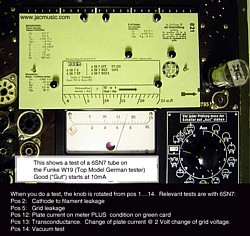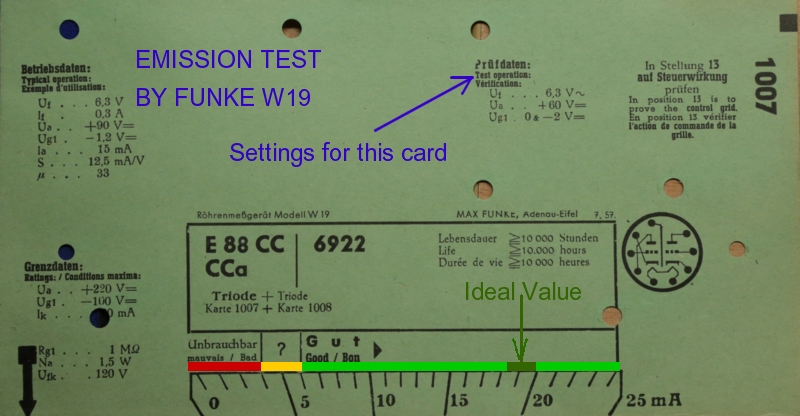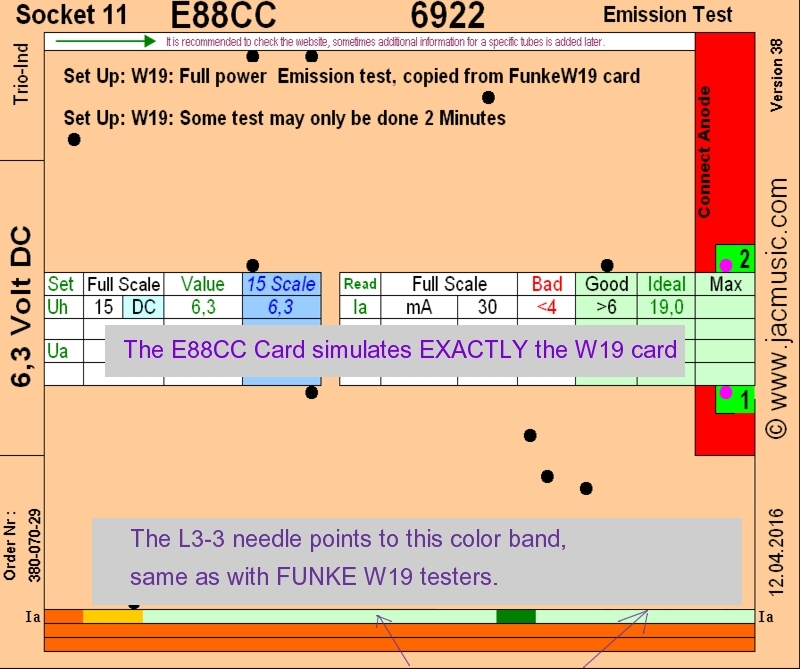Emission Test Cards on L1 and L3 tester
Emission Test Cards by FUNKE System
The test method simulates exactly the original Funke EMISSION TESTS, based on the last generation Funke Emission tester, the W19.
This L3-3 Card simulates the famous FUNKE W19 test method. To my opinion the finest emission tester ever build. Introduced by Max Funke, who spend his entire life setting up test data for tubes, dedicated to his test system, and developing two kind tube testers for this, so called emission Testers, and Parametric Testers. These cards use the Funke Emission Test method.
Short explanation:
The purpose of the W19 is to tell you if the tube is 'strong' or 'may function' or 'bad'. Specially the 'may function' range is one to consider, because if you find such a tube in a working amplifier, you can as well leave it in. These are the words of Max Funke, in the blue book, belonging to the W19 tester. W19 tells you, if the tube must be replaced or not. This is a real emission test, one of the few ones that are really good. To do it professionally, requires a regulated anode voltage, and both W19 and L3-3 have that of course. L3-3 is so versatile, it can indeed copy the configuration of the W19 tube tester + it's test card set up. So this is what those 'W19 simulation' cards do. Read the long explanation for details.
Long explanation:
The W18 tube tester is already one of the best, but it does not have the latest tube sockets, and could not test low voltage tubes for car radios. To achieve this, the W19 was developed, and there was no more need for an upgrade. It was build for a long time, until the company was closed due to high age of Mr. Funke, and there was nobody who followed him up. The factory was preserved as a time capsule for many years.
 The basic idea behind the Funke Emission testers is, to have no compromise on the construction of the machine, and yet l have an operating system which is so simple, even a fool can make no mistakes. This was necessary, because the largest buyer was the German army. The test card programs all settings, and a big arrow points at the right socket. All you must do, plug in the tube yourself. Then, step by step rotate the only knob the tester has, through it's many positions. In case of an error at one position, the needle moves to the left in the left field 'ERROR'. The tube is tested for Gas, Leakage resistance between pins and shorts. The operate is not bothered with electrical things, just he must be able to read the letter 'F' for 'Fehler' in German. If all tests are passed, the last and final test is done for Emission, and a copy of the expected meter read out is on the cards. The needle points at the word 'Bad' or ?'? or 'Good'. For interested users, there is of course all test data and settings printed on the card, and on the test knob, so tester can be used by an unskilled person, or by a skilled person at the same time.
The basic idea behind the Funke Emission testers is, to have no compromise on the construction of the machine, and yet l have an operating system which is so simple, even a fool can make no mistakes. This was necessary, because the largest buyer was the German army. The test card programs all settings, and a big arrow points at the right socket. All you must do, plug in the tube yourself. Then, step by step rotate the only knob the tester has, through it's many positions. In case of an error at one position, the needle moves to the left in the left field 'ERROR'. The tube is tested for Gas, Leakage resistance between pins and shorts. The operate is not bothered with electrical things, just he must be able to read the letter 'F' for 'Fehler' in German. If all tests are passed, the last and final test is done for Emission, and a copy of the expected meter read out is on the cards. The needle points at the word 'Bad' or ?'? or 'Good'. For interested users, there is of course all test data and settings printed on the card, and on the test knob, so tester can be used by an unskilled person, or by a skilled person at the same time.
So that is idea with the W19 is: The tester is set up in 10 seconds with a new card, and test result is immediately there, and the answer is: Good or Bad. The idea of W19 NOT, to set and change and test everything, and get presented all kind of data, from which you can decide yourself what you want to do. If that is what you need, the tester for that is Funke W20 which is similar to L3-3.
So this is the start situation. Max Funke explained his W19 measurement method in his 'blue book'. I have made it a bit more easier to read here. He writes: Let's assume, the tube manufacturer did a good job, testing a new made tube, and it has passed all tests with good results. There are only three things now, that can make the tube less CHANGE parameters. These are: Gas, Leakage, or loss of emission. If we would have a way to say for sure, there are little or no changes with a working tube, the conclusion is the tube is still in very good condition. If we could say with a very high degree of reliability, the tube has NOT changed, we would NOT need the t tube undergo a complete test sequence. So we would not have to go though this long list of static and dynamic parameters and all these things. Even almost everything we need to know is unspecified. For instance, just show me a datasheet, telling what is the reject limit for transconductance of a KT88 tube, and under what conditions we need to test this. If that would exists, at least we would know now what we have to do, but manufacturers have always been hiding this information ever since. Only for very few tubes, mainly for German Post applications, it was specified. (For instance the C3g).
So the situation is, real test information was always hidden anyway, and all we want to know: Is the tube still ok? Then the question for Max Funke was only: How can I say if the tube has changed since it was made. Well first that means it should have no leakage. So leakage tests with the W19 is done in a way which is the finest. Though not as precise as with the L3-3, the W19 rather tests EVERYTHING, which is more than L3-3 does. Systematically all grids and electrodes are checked, one by one. Here comes the basic idea again: We don't need to know the exact values of all of this, we just need to know if leakage is as low as with a new tube. If so, the tube is fine. So we don't need to know what is the exact value of the Cathode to Heater resistance is. Though of course the manufacturers knew this, they never communicated that anyway. So there is no use in testing leakage and find for instance 529,54k and nobody tells you it has to be above 500k or above 600k.
All we need to know: Is the resistance very high, and then it's ok. So yes, you can find out with the L3-3 that you have for instance 10uA at 100 Volt cathode to heater leakage, being equivalent to 10Mega Ohms, but that won't take you any further, as no manufacturer will tell that value anyway. So you're left alone with the judgment of that. Just for your information, Funke uses 400k Ohms in the W19 as the beginning of a bad value for this. In Hickok testers the Neon Lamp test is calibrated for the same value.
After the tube passes the leakage test, it's ready to do the Emission test. Here comes the basic idea behind the W19: If the emission is unchanged, this means the tube is unchanged. Regardless what that transconductance was when the tube was born, it will still have exactly this value today, if just the emission is unchanged. So how to measure emission? well, that is a very good question! For that, Funke looks at the cathode only. So indeed how many electrons can I get out of it. As we can only measure plate current of course, between cathode and anode, we need to ELIMINATE the function of all those grids in between. So the tube is tested like a diode, no matter what tube it is. Then, he makes it hard for this diode to work well. This is done on purpose to separate the good ones from the bad ones. So the working voltage of the diode is chosen lower than normal, and the plate current higher than normal. So will he tests for instance a 12AX7 at 150 Volts only, but pulls 2.4 milliampere. (Normal use is at 250V, 1.2 mA). So his test setting is hard to do for a tube with lower emission than normal, whereas the same tube at 250V 1.2 milliampere would not look so bad at all. The next thing he does is as simple as can be. The heater transformer has somewhat internal resistance, resulting in tubes that draw very much heater current to be slightly under heated. This method is used by Hickok testers as well. Tubes like KT88 or even KT90, have huge emission, but of course that is done on cost of very high heater current. So letting the heater voltage drop on purpose with such tubes, they are tested in an even more difficult situation. Then let them draw as much anode current as the tester can do, and go the lowest possible voltage for this, yet this should be a voltage which makes the tube really get hot also.
What to compare results with? Here comes the contribution of Max Funke. From their many contacts with tube manufacturers, they had a stock of reference tubes, and huge database of tube settings, all tried out on the W19. To make a card, all he had to do, take a used tube from his inventory that he knows is weak, but 'just ok' still, and put the mark 'good' at the test card just at the right position. Of course a brand new tube will read higher than that. So with the test cards that come with the tester, actually you receive all that information. On each card is written the W19 test setting for this tube (having nothing do to with a normal test), and a mark saying 'good' and a range called '?' So this pile of test cards so to say is the knowledge base, and the software too, and the W19 tester the hardware that belongs to it.
Some notes to the test ranges.
The original Funke cards give to ranges, called the '?' range, and 'good begins at'
The '?' range means the tube can probably be used still, in applications that do not use the tube at maximum settings. Many are like that, so it is advised to try such a tube in the equipment, and when it works you can still use it. Just is will probably not work very long, but also here are many exceptions.
The range 'good begins at', means a tube that is above must work in every application without exceptions. Just for very demanding applications, the tube should be safely above, like for instance 15% or more. Again here the remark that nor many applications are 'very demanding'. So when a tube just touches the mark 'good begins at', there is nothing wrong with such a tube. It's just not new anymore.
How is that done on the L3-3 cards that simulate the Funke Cards?

Some more Important notes
The Funke testers use a 150V Stabilized voltage, with a voltage divider, to get lower voltages, and a series resistor to get the higher voltages. So only the 150V is well stabilized, the other voltages will change, depending on the tube load. Yet, the test result is still exact, because the 150V is exact. This does not matter however for the test result, which is still awfully precise. On the cards, this is simply included. So if new (bogey) tube E88CC by the above card should have 19mA, it will have so indeed on any random W19 tester.
However to simulate for instance this E88CC test, you can not simply take +60V with the L3-3, but the real anode voltage must be measured from a W19, using a bogey tube.
The settings on the tester are the same as on the Funke Cards. The Funke range 'good begins at' is the same as on all L3-3 cards we make, and it is called 'good'. The reading 'ideal' that you will see too, exceeds the information by Funke, and it is only intended as a helpful number estimated to be the reading of a new (Bogey) tube. Note the color band on the Funke card is photo shopped by me, just to indicate their ranges, but the original cards don't have this coloring.
Then you see a marking 'bad' on the card. The range above 'bad' and below 'good' corresponds exactly with the Funke W19 '?' range.


Conclusion:
This was a very long explanation, but what you are receiving is a card which requires almost NO SETTINGS, and it tells you immediately if the tube is good or bad. Also, the reliability of this 'good or bad' answer, I think it cannot be done better as Max Funke, who spend his entire life, , developing the cards database, and the test principle for the W19.
When testing a tube with such a Funke Card, and the tube is 'just not ok', of course first thing you do is take a conventional test method, to see what is the problem. However, that doesn't get you any further, as you will find, the tube has lower transconductance, and bias settings too low also. are a bit lower too. However, it's a chance of 1:200 that you will find some intelligent information in the manufacturer's datasheet about this. Or even less than 1:200. Perhaps only 100 tubes exists at all, with really useful information about how much lower Gm can be, before a tube can be called bad. Or what the bias must be, to call a tube 'good' or 'just ok'. So when you think gm is to important, and you want to measure it with 3% precision, it is fine for yourself, but in the end you are left alone with the decision if the tube is good or bad. So it rather depends on what good tube testers say, and the manufacturers of those, were forced to fill that information gap.
So I think this is the best of the W19 cards, they give you the answer in a plain form:
Good means: It can be used in any application. The further in the green the more lifetime is inside.
'?' means: It may work in many applications, but not in all.
Bad means: The tube us a trouble maker, even when it appears to work.
You will find exactly the same test method and same results on the W19 simulation cards for L3-3.